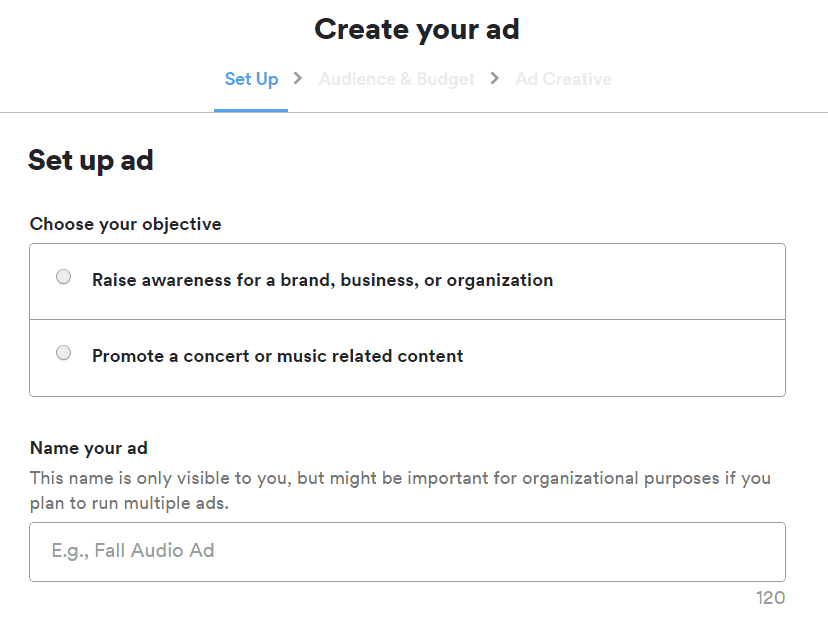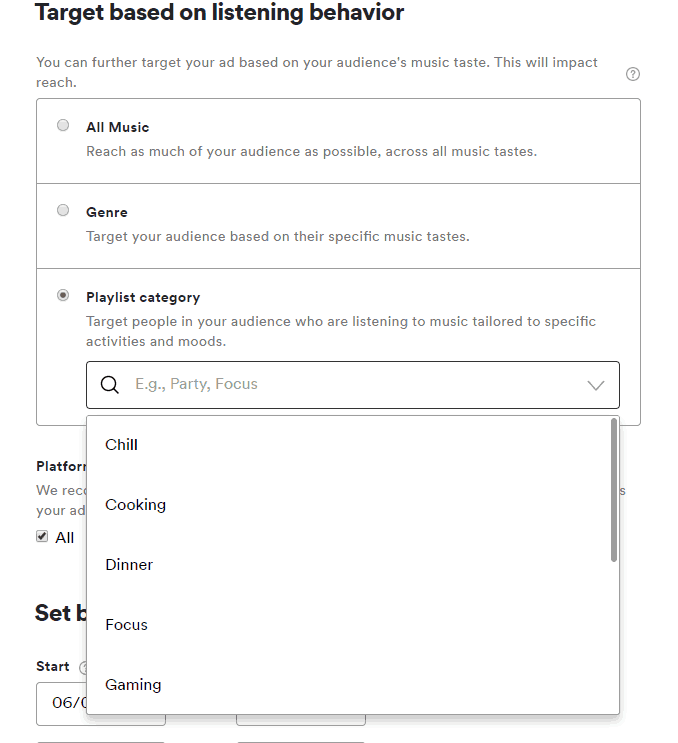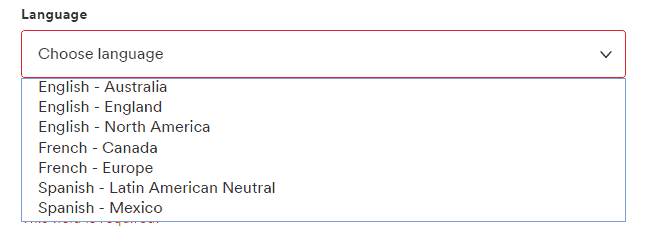As service providers rush to expand their monitisation efforts and turn a profit from their vast user bases, it seems every month a new self serve programmatic platform gets launched. If you hadn’t heard Spotify are the latest, pushing their Ad Studio product in to beta testing (for UK people) earlier this year.
But what does it look like? How do you create programmatic audio? And most importantly how does it perform?
Here are 7 things you need to know about Spotify’s Ad Studio.
1 – The basics
To kick things off Spotify keep things simple, unlike Facebook where you have over 15 different campaign objectives, Spotify gives you two:
- Raise brand awareness
- Promote a concert or music content
Your creative needs to be a 30 second audio file, along with a 640×640 “album cover” and a headline. You also need a link for your landing page where the clicks will go to.
2 – Targeting is so-so
Your campaign targeting options are very basic, even compared to Twitter’s self-serve platform. Your main targeting options are:
- Location – The search tool for this works well and finds most UK locations. You can search by country, city, county or designated market area. Unfortunately it doesn’t provide postcode search at this moment.
- Age – set your target to anything between 13 – 65+ Facebook style, much better than Twitter’s crazy age targeting options
- Gender – even though Spotify is from liberal Sweden there’s no gender spectrum here. You get All/Female/Male
- Platform – choose a mix between All, iOS, Android or Desktop
- Listening behaviour – this is something only an audio service like Spotify could provide. You can target your ad at people that listen to all types of music, or by certain genres and playlists, which is a nice twist
3 – How much you need to spend
Budgets start from £1,000 up to however much your credit card can take. And that’s the only way you can pay on self serve. No PayPal, no invoice, just plastic.
In terms of what that gets you, their platform provides some basic cost per play data. At the time of writing spending £1,000 over two weeks while targeting 16-20 year olds in the UK would cost £0.009 per play. Hone that down to London only and it goes up to £0.010 per play.
4 – How you do the audio creative
If you’re used to handling digital self-serve programmatic you’ll appreciate how easy it can be to re-purpose content for an ad. At the very basic level you can just promote a Facebook post or Tweet and see the results come running in. Most digital teams are geared up for this kind of creative. But with Spotify, it’s an audio network. Your creative needs to be a 30″ audio track, and that’s a whole new skill set.
Does that mean you need to make your own track or playlist and promote that? Before you craft a lyrical master piece and hit the studio to go full Band Aid on the mic, Spotify have you covered.

Spotify’s Ad Studio lets you upload a script, preview and pick a backing track and they’ll do the rest. You even get to choose the voice over “language” and age as well as provide some textual direction on how you’d like it delivered.
Having worked in radio advertising production this seemed like a pretty basic way of doing things. I was used to having audio samples of all the voice overs I wanted to work with, knew who I had in mind for certain scripts and could be there when the voice over did their thing, providing live feedback and coach them to deliver my scripted masterpiece exactly how I wanted.
If you want Spotify to make your ad, you’re removed from the recording process which leads to some interesting results.
5 – The voice overs are interesting
Unlike the backing track, Spotify’s Ad Studio doesn’t let you preview any of the voice over options. Which was a bit weird. The end results ended up weird too.
I picked their “English-England” (sadly no Geordie) voice over and “Male| Young Adult”. Expecting a young sounding male with an South English accent I was quite surprised when I was asked to approve something that sounded more like a Dutch guy putting on a cockney accent?
But that’s ok, sort of, because:
6 – You can reject your voice over
Yup, if the recording doesn’t cut the mustard you can either provide some feedback and hope they do a better job, or just straight up reject the recording.
Providing feedback means the same voice over will go off and record a new version based on your feedback. It didn’t help for us so we had to reject.
Unfortunately rejecting the voice over doesn’t mean you get to just pick a new voice over option from the list. Nope, instead you’ve got to start your entire campaign again – which is annoying to say the least as we had to reject two voice overs before finding one we liked.
All this hassle could have been saved if Spotify provided the option to preview samples of the voice overs to find the right one. However, we did get someone suitable eventually and the campaign went live. Which leads to:
7 – The results
After all the fun and games of getting the campaign set up (with all the voice over rejections it took over a week to get live) traffic did come to the website.
As you’d expect from an audio medium, the direct link traffic was no where near an avalanche. This is all about brand awareness and getting your name out there.
Final thoughts
It’s great to see Spotify opening up its platform for self serve adverts, and they’re trying to make it as simple as possible to get people up and running. But it’s far from perfect and lacks some basic functions to bring it in to the leagues of other self-serve digital programmatic. However, they’re still in beta and it’s early days.
As they build the platform out, there are some things I think they could include to help make it more user friendly:
- Get some voice over previews – if you can hear what the backing track is going to be, why can’t you hear what your potentially voice over will be like? If we could have been pre-warned of the Dutch Cockney it would have been schooo much easier
- Get on the pixel action – granted this usually comes later with self-serve platforms but people are used to getting that sweet sweet additional conversion data with digtal ads thanks to web pixels. Sure GDPR has got people worried but when they’re implemented properly they can provide the advertisers with important conversion information and users with better adverts. It’ll also help provide some attribution for Spotify web traffic that weren’t direct clicks.
- Don’t make the reject button kill everything – just because you don’t like the voice over recording it doesn’t meant the whole campaign should be ditched. Rejecting the voice recording should do just that and let you pick a new one, rather than start the whole campaign again
- More demographic targeting – the targeting by music taste is nice, but as a digital advertiser I’m used to getting my targeting much more laser focused




Comments are closed.